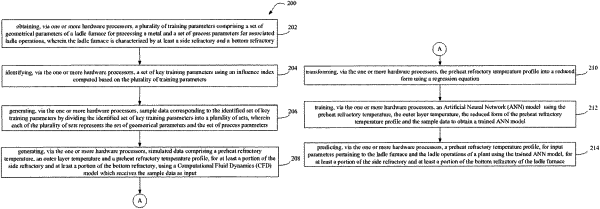| CPC G05B 19/4155 (2013.01) [G06N 3/08 (2013.01); G05B 2219/45132 (2013.01)] | 15 Claims |

|
1. A processor implemented method comprising the steps of:
obtaining, via one or more hardware processors, a plurality of training parameters comprising a set of geometrical parameters of a ladle furnace for processing a metal and a set of process parameters for associated ladle operations, wherein the ladle furnace is characterized by at least a side refractory and a bottom refractory;
identifying, via the one or more hardware processors, a set of key training parameters using an influence index computed based on the plurality of training parameters;
generating, via the one or more hardware processors, sample data corresponding to the identified set of key training parameters by dividing the identified set of key training parameters into a plurality of sets, wherein each of the plurality of sets represents the set of geometrical parameters and the set of process parameters;
generating, via the one or more hardware processors, simulated data comprising a preheat refractory temperature, an outer layer temperature and a preheat refractory temperature profile, for at least a portion of the side refractory and at least a portion of the bottom refractory, using a Computational Fluid Dynamics (CFD) model which receives the sample data as input;
transforming, via the one or more hardware processors, the preheat refractory temperature profile into a reduced form using a regression equation; and
training, via the one or more hardware processors, an Artificial Neural Network (ANN) model using the preheat refractory temperature, the outer layer temperature, the reduced form of the preheat refractory temperature profile and the sample data to obtain a trained ANN model.
|